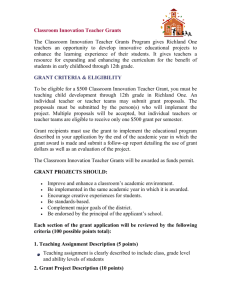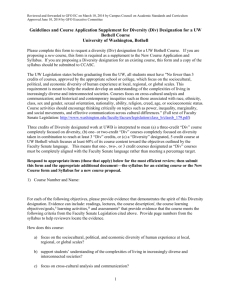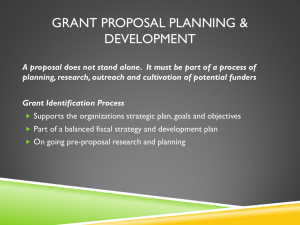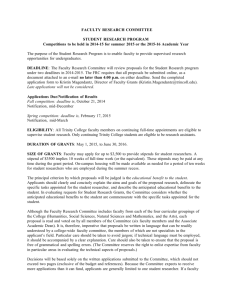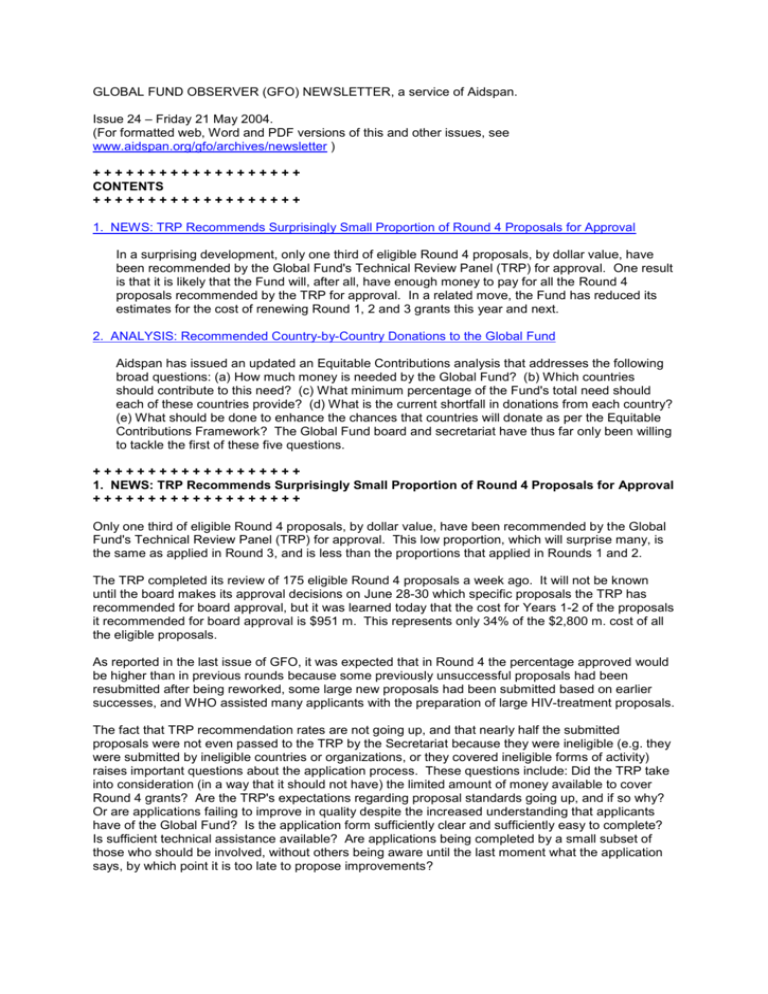
GLOBAL FUND OBSERVER (GFO) NEWSLETTER, a service of Aidspan.
Issue 24 – Friday 21 May 2004.
(For formatted web, Word and PDF versions of this and other issues, see
www.aidspan.org/gfo/archives/newsletter )
+++++++++++++++++++
CONTENTS
+++++++++++++++++++
1. NEWS: TRP Recommends Surprisingly Small Proportion of Round 4 Proposals for Approval
In a surprising development, only one third of eligible Round 4 proposals, by dollar value, have
been recommended by the Global Fund's Technical Review Panel (TRP) for approval. One result
is that it is likely that the Fund will, after all, have enough money to pay for all the Round 4
proposals recommended by the TRP for approval. In a related move, the Fund has reduced its
estimates for the cost of renewing Round 1, 2 and 3 grants this year and next.
2. ANALYSIS: Recommended Country-by-Country Donations to the Global Fund
Aidspan has issued an updated an Equitable Contributions analysis that addresses the following
broad questions: (a) How much money is needed by the Global Fund? (b) Which countries
should contribute to this need? (c) What minimum percentage of the Fund's total need should
each of these countries provide? (d) What is the current shortfall in donations from each country?
(e) What should be done to enhance the chances that countries will donate as per the Equitable
Contributions Framework? The Global Fund board and secretariat have thus far only been willing
to tackle the first of these five questions.
+++++++++++++++++++
1. NEWS: TRP Recommends Surprisingly Small Proportion of Round 4 Proposals for Approval
+++++++++++++++++++
Only one third of eligible Round 4 proposals, by dollar value, have been recommended by the Global
Fund's Technical Review Panel (TRP) for approval. This low proportion, which will surprise many, is
the same as applied in Round 3, and is less than the proportions that applied in Rounds 1 and 2.
The TRP completed its review of 175 eligible Round 4 proposals a week ago. It will not be known
until the board makes its approval decisions on June 28-30 which specific proposals the TRP has
recommended for board approval, but it was learned today that the cost for Years 1-2 of the proposals
it recommended for board approval is $951 m. This represents only 34% of the $2,800 m. cost of all
the eligible proposals.
As reported in the last issue of GFO, it was expected that in Round 4 the percentage approved would
be higher than in previous rounds because some previously unsuccessful proposals had been
resubmitted after being reworked, some large new proposals had been submitted based on earlier
successes, and WHO assisted many applicants with the preparation of large HIV-treatment proposals.
The fact that TRP recommendation rates are not going up, and that nearly half the submitted
proposals were not even passed to the TRP by the Secretariat because they were ineligible (e.g. they
were submitted by ineligible countries or organizations, or they covered ineligible forms of activity)
raises important questions about the application process. These questions include: Did the TRP take
into consideration (in a way that it should not have) the limited amount of money available to cover
Round 4 grants? Are the TRP's expectations regarding proposal standards going up, and if so why?
Or are applications failing to improve in quality despite the increased understanding that applicants
have of the Global Fund? Is the application form sufficiently clear and sufficiently easy to complete?
Is sufficient technical assistance available? Are applications being completed by a small subset of
those who should be involved, without others being aware until the last moment what the application
says, by which point it is too late to propose improvements?
The one positive consequence of this development is that it is likely that the Fund will, after all, have
enough money to pay for all the Round 4 proposals recommended by the TRP for approval. (The
Fund estimated some time ago that it would have about $900 m. to pay for Years 1-2 of approved
Round 4 grants, and the amount available may increase if new donations come in.)
The table below shows approval rates for Rounds 1 through 4.
Proposals Submitted to the Global Fund in Rounds 1 to 4
Number of
eligible
proposals
Round 1: Submitted
of which, Approved
Round 2: Submitted
of which, Approved
Round 3: Submitted
of which, Approved
Round 4: Submitted
of which, recommended
for approval
204
58
229
98
180
71
c. 175
Not known
Percent
28%
43%
39%
Not known
Cost of
Years 1-2
Percent
c. $1,500 m.
$578 m.
$2,137 m.
$878 m.
$1,853 m.
$623 m.
c. $2,800 m.
$951 m.
c. 39%
41%
34%
c. 34%
In a related development, the Fund has reduced its forecast of the cost of renewing grants from
Rounds 1, 2 and 3 this year and next. In January, the Fund forecast that costs of grant renewals
would be as follows:
In 2004: Initial renewals of Round 1: $410 m.
In 2005: Renewals of Rounds 1, 2 and 3: $1,580 m.
But now, the Fund is forecasting as follows:
In 2004: Initial renewals of Round 1: $240 m.
In 2005: Renewals of Rounds 1, 2 and 3: $1,350 m.
This could mean that grants are progressing slower than anticipated; or it could mean that the cost for
some grants of Years 3-5 will be less than originally anticipated; or it could mean that some grants are
expected to be cancelled before the completion (or even the start) of Years 1-2.
+++++++++++++++++++
2. ANALYSIS: Recommended Country-by-Country Donations to the Global Fund
+++++++++++++++++++
[Note: The following report was published today by Aidspan, the NGO that produces GFO. The
version as reprinted here does not include the detailed tables of data that are contained in two
appendices. Footnotes, in square brackets, have been moved to the end. The 7-page full version of
the paper is available at www.aidspan.org/gfo/docs/gfo61.pdf The spreadsheet containing all the
data upon which the paper is based is available at www.aidspan.org/gfo/docs/gfo60.xls ]
Title: An Updated Analysis of the Equitable Contributions Framework regarding the Global
Fund [1]
Aidspan – 21 May 2004
1. Introduction
The Global Fund to Fight AIDS, TB and Malaria, controlled by governments and civil society, was
established in 2002 to raise money to tackle AIDS (described by many as the world's greatest current
challenge) plus TB and malaria.
2
In April 2002, a paper entitled "The Global Fund: Which Countries Owe How Much?" proposed that
contributions to the Fund should be made according to an "Equitable Contributions Framework," in
which donor countries contribute in relation to the sizes of their economies. [2]
The "Equitable Contributions" concept has since been widely promoted by non-governmental
organizations. In addition, President Chirac of France implicitly adopted the concept by proposing
that the Fund's needs should be provided one third by the USA, one third by Europe, and one third by
others. And the US Congress passed legislation that the US contribution to the Global Fund shall be
(no more than) one third of the total given to the Fund.
This paper seeks to update the Equitable Contributions analysis. It addresses the following broad
questions: (a) How much money is needed by the Global Fund? (b) Which countries should
contribute to this need? (c) What minimum percentage of the Fund's total need should each of these
countries provide? (d) What is the current shortfall in donations from each country? (e) What should
be done to enhance the chances that countries will donate as per the Equitable Contributions
Framework? The Global Fund board and secretariat have thus far only been willing to tackle the first
of these five questions.
2. Assumptions
The analysis below is based on the following assumptions:
(a) As stated by the Global Fund, the Fund needs to receive at least $1.4 billion during 2004 and
$3.3 billion during 2005. [3] (The increase between 2004 and 2005 is because in 2005 many
grants approved in the first three rounds will become eligible for renewal, and because in
2005, unlike in 2004, there will be two new rounds if the Fund continues its past practice of
launching a new round every eight months.)
(b) As proposed by President Chirac of France, and others: [4] The Global Fund's needs should
be provided one third by the USA (which has 32.2% of world GNP); one third by European
Union (EU) [5] countries (which have 26.7% of world GNP); and one third by "Other" countries
(which have 41.1% of world GNP). It is generally accepted that contributions by civil society
(foundations, corporations, and individuals) should be added to the "Other" category.
(c) As proposed on many occasions by non-governmental organizations: Within each of these
one-thirds, "equitable contributions" should be made to the Global Fund by each of the world's
relatively affluent nations, who should contribute in proportion to their GNP. [6] (Additional
contributions are welcome from other countries, and, as just stated, from civil society.) In this
paper, we propose that the equitable contributions should come from the 41 countries that are
defined by the World Bank as "high-income." [7] [8] [9]
3. Key findings
The Appendices [10] show how much has been pledged to the Global Fund thus far, and compare
this with how much should be pledged by various countries according to the Equitable Contributions
Framework analysis. They show that:
(a) Total money promised thus far to the Global Fund for 2004 is $1,515 m., which is slightly in
excess of the $1,400 m. needed. The promises have come 53% from EU nations (which
have 27% of the world's GNP), 36% from the USA (which has 32% of the world's GNP), and
11% from "Other" (which have 41% of the world's GNP – though half of this GNP share is
attributable to over 100 non-high income countries).
(b) Total money promised thus far for 2005 is $842 m., which is only 26% of the $3,300 m.
needed. This has come 69% from EU nations, 24% from the USA, and 8% from "Other."
(c) Total money actually paid to the Global Fund since it was founded is $2,477 m. This has
come 55% from EU nations, 25% from the USA, and 20% from "Other."
3
(d) The portion of its Equitable Contribution that each of the 41 high-income countries has
pledged for 2004 and for 2005 is as in the following table. Countries represented on the
board [11] are shown with asterisks. As can be seen, many countries have already pledged
more than their Equitable Contribution for 2004. (This helps offset the low performance by
"Other".) But 21 of the 41 high-income countries have not yet made any pledge for either
year. High-income countries that are represented on the board but are still significantly below
their Equitable Contributions for 2004 are Austria, Canada, Japan and Switzerland.
Portion of its Equitable Contribution that each of the 41 high-income countries has pledged for 2004
and 2005
Andorra
Antigua & Barbuda
Australia
Austria *
Bahamas
Bahrain
Barbados
Belgium *
Brunei
Canada *
Cyprus
2004 2005
0%
0% Denmark *
0%
0% Finland
40%
6% France *
0%
0% Germany
0%
0% Greece
0%
0% Iceland
0%
0% Ireland *
>100%
0% Israel
0%
0% Italy *
51% 44% Japan *
0%
0% Korea, South
2004 2005
>100%
0% Kuwait
0%
0% Liechtenstein
>100% >100% Luxembourg *
100%
35% Malta
0%
0% Monaco
37%
0% Netherlands *
>100%
0% New Zealand
0%
0% Norway *
>100%
84% Portugal
33%
0% Qatar
2%
0% San Marino
2004 2005
0%
0% Singapore
>100%
0% Slovenia
>100%
0% Spain *
0%
0% Sweden *
0%
0% Switzerland *
>100% >100% United Arab Emirates
0%
0% United Kingdom *
>100%
0% United States *
0%
0%
0%
0%
0%
0%
2004
2005
3%
1%
0%
0%
100%
33%
>100%
0%
0%
0%
0%
0%
>100%
30%
>100%
18%
(e) Although there is an unwritten understanding that each of the seven donor countries (or
groups of countries) that hold Global Fund board seats should contribute at least $100 million
annually to the Fund, three of the donor board delegations have not yet pledged to this level
for 2005. These are Sweden + Denmark + Ireland + Netherlands + Norway ($60 m. pledged);
European Commission + Austria + Belgium ($51 m. pledged); and Japan ($0 pledged).
(f) Although the Global Fund describes itself as a "public-private partnership," over 95% of the
money contributed to the Fund thus far has come from governments, with under 5% ($104
million) coming from civil society (foundations, corporations and individuals). And the vast
majority ($100 m.) of the civil society contribution has come from the Gates Foundation.
Furthermore, the total amount pledged thus far by civil society for 2004 and 2005 is zero. [12]
[13]
4. Recommendations
(a) Donors who have not yet made contributions at least up to their Equitable Contributions for
2004 should do so urgently. [14] (The main donors who are behind for 2004, and their current
shortfalls, are Japan – $201 m.; Canada – $24 m.; South Korea – $32 m.; Australia – $16 m.;
and Switzerland – $18 m. [15])
(b) Donors should recognize that the Equitable Contributions Framework represents minimum
donations. (If some countries give amounts equal to these minimums, and none give more,
and some give less, the Fund will enter into a downward spiral.)
(c) At its June board meeting, the Fund should pass resolutions covering the next five
recommendations.
(d) The Fund should formalize its past practice of approving a new round of grants every eight
months. [16]
(e) The Fund should remain "demand-driven." [17]
(f) The Fund should move to a system (similar to the "just in time" approach widely used by
manufacturing companies) in which the Fund and donors agree that no money pledged by
donors will be handed over to the Fund until shortly before it must be spent by the Fund. [18]
(g) In 2005, the Fund should introduce a new system for determining which donor countries are
eligible to be members of board delegations, as follows: First, the only high-income countries
eligible to be members of board delegations during 2006-7 should be those that in 2004 and
4
2005 make donations to the Global Fund equal to or greater than their Equitable
Contributions for those years. Second, among the countries deemed to be eligible according
to this rule, each of the four countries with the highest total 2004+2005 dollar contributions
should have a board seat to itself; the remaining eligible countries should share the remaining
three donor seats in a way to be negotiated among themselves. [19]
(h) Because the willingness of donors to commit to the Fund will increasingly depend upon
evidence that past grants have let to the promised results, the Fund should regularly publish a
report stating which grants have, and which have not, delivered promised results. The report
should contain recommendations on how to accelerate poorly-performing grants; the Fund
should facilitate the provision of technical assistance where needed; and the Fund should
terminate grants that do not subsequently make adequate improvements. [20]
Appendix 1: Global Fund Equitable Contributions Framework, 21 May 2004 – Summary
[Available in the full version of the paper at www.aidspan.org/gfo/docs/gfo61.pdf ]
Appendix 2: Global Fund Equitable Contributions Framework, 21 May 2004 – Details
[This provides a donor-by-donor analysis. It is available in the full version of the paper at
www.aidspan.org/gfo/docs/gfo61.pdf ]
Footnotes
[1]
Queries to: Bernard Rivers (Executive Director, Aidspan, and editor of "Global Fund Observer.")
Rivers@aidspan.org; +1-212-662-6800; www.aidspan.org.
[2]
"The Global Fund: Which Countries Owe How Much?", 21 April 2002, Tim France, Gorik Ooms
and Bernard Rivers. See www.aidspan.org/gfo/docs/gfo15.htm. Unknown to the authors,
conceptually-similar work had previously been done by others, including Mohga Kamal Smith of
Oxfam.
[3]
All figures are in US dollars. The Global Fund's forecast as of 10 May 2004 was that the Fund
needs $1,402 m. in 2004 ($162 m. for part of Round 3, $240 m. for initial renewals of Round 1,
and $1,000 m. for the first two years of Round 4) plus $3,350 m. in 2005 ($1,350 m. for renewals
of Rounds 1, 2 and 3, $1,000 m. for the first two years of Rounds 5, and $1,000 m. for the first
two years of Round 6). (See www.theglobalfund.org/en/files/factsheets/resource_needs.pdf.)
Since then, the Fund's Technical Review Panel has reviewed 175 eligible Round 4 proposals,
and has decided which of these to recommend to the board for approval. The identify of those
recommended for approval is not yet known, but it is known that their cost for Years 1-2 is
$951 m.
[4]
The Fund stated at www.theglobalfund.org/cn/about/fighting/history, "June [2003]: G8 Summit in
Evian … French President Jacques Chirac calls for a $1 billion contribution [to the Global Fund]
from Europe to be matched by a similar contribution from the United States and a third billion
from the rest of the world."
[5]
The membership of the European Union increased to 25 countries on 1 May 2004.
[6]
GNP = Gross National Product. (The more current term for GNP is Gross National Income,
GNI.) GNP equals Gross Domestic Product (GDP) plus net receipts of primary income
(compensation of employees and property income) from abroad.
[7]
The World Bank's definition of which countries are "high-income" lists the 41 countries shown in
Appendix 2, plus 14 small territories (ignored in this paper) that are not UN members.
[8]
The ten largest economies that are not defined by the World Bank as high-income (because
they do not have sufficiently high GNP per capita), and thus that are not defined here as ones
that should pay Equitable Contributions to the Global Fund, are, in decreasing order of
economic size, China, Mexico, India, Brazil, Russia, Saudi Arabia, Poland, Turkey, Argentina,
5
and Indonesia. Five of these (China, Mexico, Russia, Saudi Arabia and Poland) have still
chosen to make contributions to the Fund.
[9]
For members of the European Union, Equitable Contributions have been calculated by
subtracting (from one third of the amount needed by the Global Fund) the pledge that has been
made to the Global Fund by the European Commission, and then dividing the remaining
requirement among the EU nations in proportion to their GNP.
[10] Summary tables are shown in Appendix 1. More detailed tables are shown in Appendix 2.
Pledge data in the appendices is as was posted by the Fund at
www.theglobalfund.org/en/files/pledges&contributions.xls on 20 May 2004, except that it
corrects the Canadian pledge for 2005 from CDN$70 m. plus US$25 m. to CDN$70m. only. The
spreadsheet upon which the appendices are based (and which contains all the source data) is
available for download at www.aidspan.org/gfo/docs/gfo60.xls.
[11] Currently, the seven donor board sets are occupied by Italy; Japan; USA; Canada + UK +
Switzerland; European Commission + Austria + Belgium; France + Germany + Luxemburg +
Spain; and Sweden + Denmark + Ireland + Netherlands + Norway.
[12] In addition, $82,000 has been received from civil society during 2004 in the form of un-pledged
gifts.
[13] Some foundations have made in-kind contributions of time and expertise, and some
corporations are discussing with the Fund ways in which they might make in-kind contributions
of materials – though finding broadly acceptable forms of this is proving difficult. In additions,
some corporations have engaged in "co-investment," in which they extend the impact of Global
Fund grants by providing access to their infrastructure and human resources.
[14] There are two reasons for urgency. First, the board must be sure that it will have enough money
to approve all the Technical Review Panel-recommended Round 4 proposals at the June board
meeting. Second, although the US has pledged $547 m. for 2004, this is conditional on the US
contribution for 2004 not exceeding one third of the total given by all donors. At present, only
$476 m. of this will be given by the US, because to give more would take the US over the one
third ceiling. New pledges must be received from others by July to avoid this ceiling coming into
play.
[15] For details on these and other donors, see Appendix 2, Table 2A, in the column for "Pledges for
2004: Current shortfall."
[16] The Fund's board meets three times per year (roughly each spring, summer and autumn), and
thus far has approved a new round of grants every second board meeting. Round 4 grants will
be approved at the eighth board meeting, in June 2004. If that schedule continues, Round 5 will
be launched in late 2004 and approved in spring 2005, and Round 6 will be approved in autumn
2005. However, this schedule is under threat. First, the board has resolved that paying for
grant renewals will take precedence over paying for new grants, which means that starting in
early 2005 there will be constant risk that there is insufficient money to launch new rounds.
Second, the board's resolution last October that "the Board will announce a minimum of one Call
for Proposals per calendar year" leaves open the possibility that Round 5 will be launched as
late as 31 December 2005 and approved in spring 2006.
[17] The Fund thus far has been "demand-driven," in which there is a moral commitment for donors
to contribute enough money to finance all the proposals that the Technical Review Panel
recommends. However, recent developments (such as the decision to shift to funding primarily
via a "replenishment conference" every two or three years) would shift the Fund to being largely
"supply-driven," in which donors are not under any significant pressure to provide more funding
than they choose.
[18] The Fund has a policy that it will only sign a grant agreement if it has cash or binding promissory
notes on hand sufficient to cover the expenditures implied by the grant agreement. This has led
to some potential donors being unwilling to make pledges because "the Fund is sitting on a
6
mountain of money" – even though that money is all committed. This problem would be avoided
if donors delivered their commitments in the form of promissory notes, followed by cash at the
last minute. This option is already available to donors, but few have made use of it.
[19] If this policy were introduced a year earlier (and was based on pledges in 2004 only), donor
countries whose board membership is at risk would be Austria, Canada, Japan and Switzerland.
[20] The slow movement of funds from Principal Recipients (the organizations or government
departments that receive the grants from the Fund) to the agencies that will actually deliver the
needed services to infected and affected people is proving to be a serious problem. This not
only leads to thousands of avoidable deaths; it reduces the chances that donors will provide
adequate funding for new grants.
+++++++++++++++++++
END OF NEWSLETTER
+++++++++++++++++++
This is an issue of the GLOBAL FUND OBSERVER (GFO) NEWSLETTER.
The GFO NEWSLETTER is an independent source of news, analysis and commentary about the
Global Fund to Fight AIDS, TB and Malaria (www.theglobalfund.org). The GFO Newsletter is emailed
to about 5,000 subscribers once to twice a month.
Aidspan and the Global Fund have no formal connection, and Aidspan accepts no grants or fees from
the Global Fund. The Global Fund bears no responsibility for the content of GFO or of any other
Aidspan publication.
GFO has an Editorial Advisory Board comprising ICASO, GNP+ and the AIDS NGO Network in East
Africa (the three organizations designated as Communications Focal Points within the Global Fund's
NGO board delegations), and the International HIV/AIDS Alliance. GFO is currently provided in
English only. It is hoped later to provide it in additional languages.
GFO is a free service of Aidspan (www.aidspan.org), based in New York, USA. Aidspan is a nonprofit
organization that promotes increased support for, and effectiveness of, the Global Fund.
GFO Editor: Bernard Rivers (rivers@aidspan.org, +1-212-662-6800)
Reproduction of articles in the Newsletter is permitted if the following is stated: "Reproduced from the
Global Fund Observer Newsletter (www.aidspan.org/gfo), a service of Aidspan."
To stop receiving the GFO NEWSLETTER, send an email to
stop-gfo-newsletter@aidspan.org
Subject line and text can be left blank.
To receive the GFO NEWSLETTER (if you haven't already subscribed), send an email to
receive-gfo-newsletter@aidspan.org
Subject line and text can be left blank. (You will receive one to two issues per month.)
For GFO background information and previous issues, see
www.aidspan.org/gfo
For a collection of papers on the Global Fund, see
www.aidspan.org/globalfund and www.theglobalfund.org/en/about/publications
For information on all approved and rejected proposals submitted to the Global Fund, see
www.aidspan.org/globalfund/grants
People interested in writing articles for GFO are invited to email the editor, above.
Copyright (c) 2004 Aidspan. All rights reserved.
7

